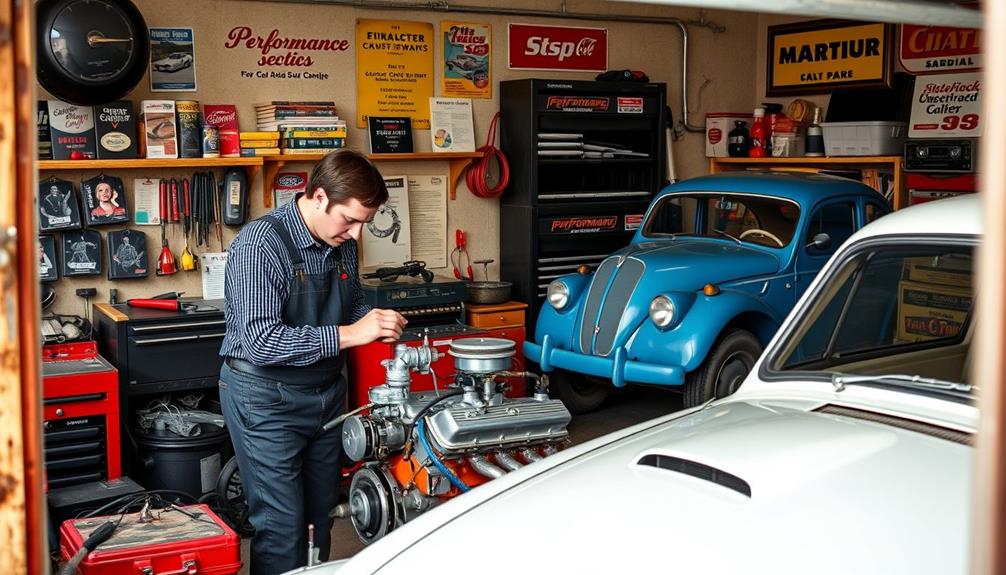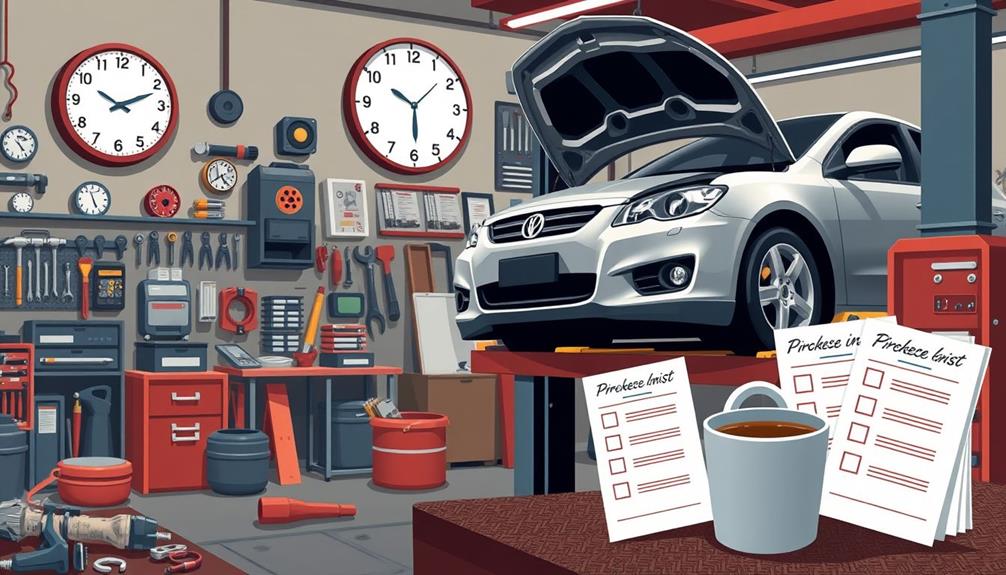Car tuning began in the early 1900s, focusing initially on simple performance enhancements. You'd see early enthusiasts experimenting with engine modifications and lightweight materials. By the 1920s, innovations like turbochargers and improved air induction methods emerged. The post-war hot-rodding craze in the 1950s and 1960s further popularized the practice, making DIY mods trendy. The 1980s ushered in hot hatches, while the 1990s fueled body kit popularity. Today, car tuning reflects individual expression, using advanced technologies for customization. If you're curious about how these trends shaped modern practices, you'll find even more fascinating details ahead.
Key Takeaways
- Car tuning began in the early days of automobiles, focusing primarily on performance enhancements.
- The 1920s saw the application of Gottlieb Daimler's air induction principles to engine tuning.
- Turbochargers, initially designed for aircraft, gained popularity in the tuning community for boosting engine power.
- The post-war era sparked a hot-rodding movement, fueled by returning military personnel's interest in speed.
- The 1960s marked the rise of DIY modifications, driven by racing designs and the desire for personal expression in car tuning.
Origins of Car Tuning
Car tuning traces its origins back to the early days of automobiles when enthusiasts began experimenting with modifications to enhance performance and express individuality. This movement has evolved into a multi-billion dollar industry, with companies offering a range of aftermarket parts and services to cater to the demands of those seeking to improve the look and feel of their vehicles. One of the most sought-after levels of modification is known as “stage 3 car tuning,” which typically involves significant upgrades to the engine, transmission, and suspension systems. This advanced level of customization is designed to push a vehicle’s performance capabilities to their limits, appealing to a niche market of enthusiasts who prioritize speed and power.
In the 1920s, the concept of tuning gained traction, especially when Gottlieb Daimler applied air induction principles to engines. This innovation laid the groundwork for performance modifications that would later define car culture.
As the years went by, turbochargers, initially designed for aircraft engines, made their way into the tuner scene, dramatically increasing engine power.
You'd see early tuners swapping out engines, particularly flathead Ford engines, to boost horsepower and overall performance. This practice became a hallmark of car tuning, allowing enthusiasts to customize their rides like never before.
The post-war era saw a surge in hot-rodding, as military personnel, who'd developed a taste for speed, began modifying their cars for enhanced performance.
This marked a significant turning point in the evolution of car tuning, showcasing a community driven by the desire to push the limits of what their vehicles could achieve.
Whether through turbochargers or engine swaps, these early modifications set the stage for the vibrant tuning culture that's known to us today.
Evolution of Performance Modifications
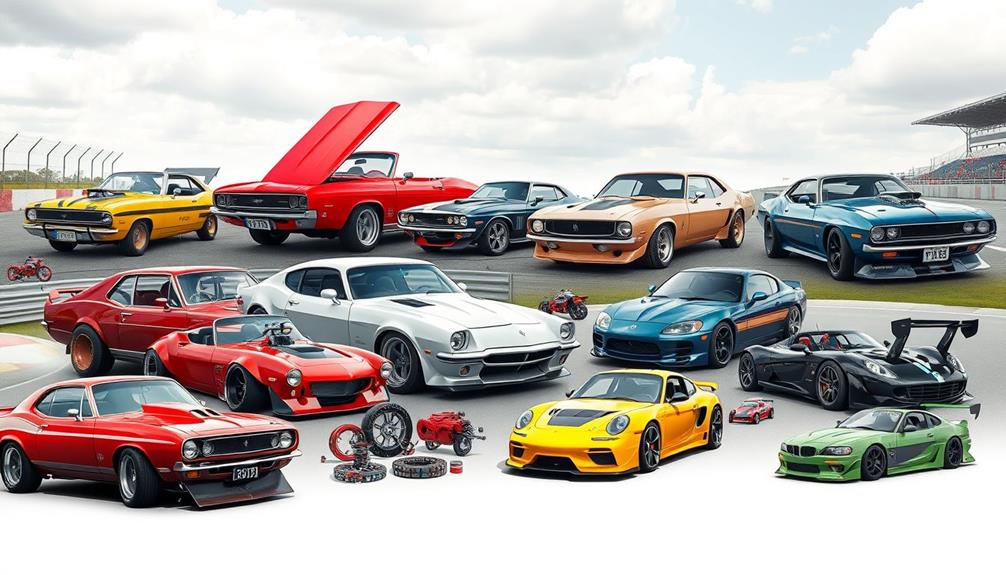
As car enthusiasts sought more speed and power, the evolution of performance modifications gained momentum, transforming how vehicles were customized. This journey began in the early days of automobiles, where mechanical adjustments allowed drivers to enhance their rides. In the 1960s, the Mini popularized DIY modifications, inspiring amateur tuners to replicate racing designs and making performance upgrades accessible.
The 1980s introduced hot hatches, which made performance modifications a norm. Features like forced induction and lightweight body kits became staples in car tuning culture. The 1990s intensified this trend, amplifying the bodykit craze and leading to brands focusing on aftermarket tuning parts.
Today, performance modifications have embraced advanced technologies, shifting from simple upgrades to highly specialized enhancements like engine management systems and turbocharging. This evolution reflects not just a desire for speed, but also a passion for personal expression through car customization.
| Decade | Notable Trends | Key Features |
|---|---|---|
| 1960s | DIY Modifications | Racing-inspired designs |
| 1980s | Hot Hatches | Forced induction, lightweight kits |
| 1990s | Bodykit Craze | Aesthetic and performance upgrades |
| 2000s-Present | Advanced Technologies | Engine management, turbocharging |
Key Tuning Techniques

When you think about key tuning techniques, engine modifications and suspension tuning stand out as essential components.
By upgrading camshafts and adjusting shock absorbers, you can greatly enhance your vehicle's performance and handling.
Let's explore how these techniques can transform your ride.
Engine Modifications Techniques
Engine modifications have transformed dramatically over the years, becoming essential for enthusiasts looking to boost performance. From basic enhancements like air filters and exhaust systems to advanced techniques such as turbocharging and ECU tuning, performance tuning has reached new heights. Here are some popular engine modification techniques you can consider:
| Technique | Description | Benefits |
|---|---|---|
| Camshaft Changes | Upgrading camshafts for better airflow | Increases horsepower and torque |
| Nitrous Systems | Adding a nitrous oxide system | Provides a temporary power boost |
| Cold-Air Intakes | Installing cold-air intakes | Improves engine efficiency |
| Engine Swaps | Replacing engines, like with a small-block Chevy | Enhances overall performance |
Standalone engine management systems now allow for user programmability, giving you the power to optimize performance further. Common upgrade components, such as high-performance pistons, valves, and headers, collectively contribute to improved engine efficiency and power output. By combining these engine modifications, you can greatly elevate your vehicle's performance, making your driving experience all the more thrilling.
Suspension Tuning Adjustments
Enhancing a vehicle's performance isn't just about engine modifications; suspension tuning plays an essential role in how your car handles on the road. By adjusting your vehicle's suspension system, including springs, shock absorbers, and anti-roll bars, you can greatly improve ride quality, handling, and stability.
If you're looking to enhance cornering performance, consider installing shorter springs. These can increase stiffness and lower your vehicle's center of gravity, though be mindful that this may affect suspension geometry. Stiffer shock absorbers also come into play, enhancing dynamic weight shifting during cornering, which gives you better control and responsiveness.
For off-road enthusiasts, suspension tuning focuses on extending suspension travel and accommodating larger tires. This adjustment improves handling and performance on rough terrains.
Your choice of suspension setup—be it air suspension, coilovers, or traditional springs—directly influences both your driving experience and your vehicle's aesthetic stance.
Ultimately, effective suspension tuning allows you to tailor your car's handling characteristics to match your driving style, ensuring top performance while considering factors like vehicle weight.
Get ready to experience a whole new level of driving dynamics!
Cultural Impact of Car Tuning

Car tuning has carved out a significant cultural niche, evolving from a niche hobby into a global phenomenon. Since the post-war era, particularly the 1960s, car tuning has attracted enthusiasts keen to enhance speed and performance. The 1980s marked the rise of hot hatches, making performance modifications more accessible, while the 1990s introduced the "Fast and Furious" franchise, which popularized Japanese cars and vibrant customization.
Social media has transformed this scene, allowing you to share your modifications and connect with fellow enthusiasts worldwide. Various subcultures have emerged, each showcasing unique preferences and styles within the car tuning community.
Here's a quick look at some major influences in car tuning culture:
| Decade | Key Influence | Notable Cars |
|---|---|---|
| 1960s | Post-war performance | Muscle Cars |
| 1980s | Hot hatch phenomenon | VW Golf GTI |
| 1990s | "Fast and Furious" impact | Nissan Skyline |
The cultural significance and creativity of car tuning are undeniable, as it continues to inspire a diverse array of enthusiasts seeking to express themselves through their vehicles.
Regulations and Legal Considerations
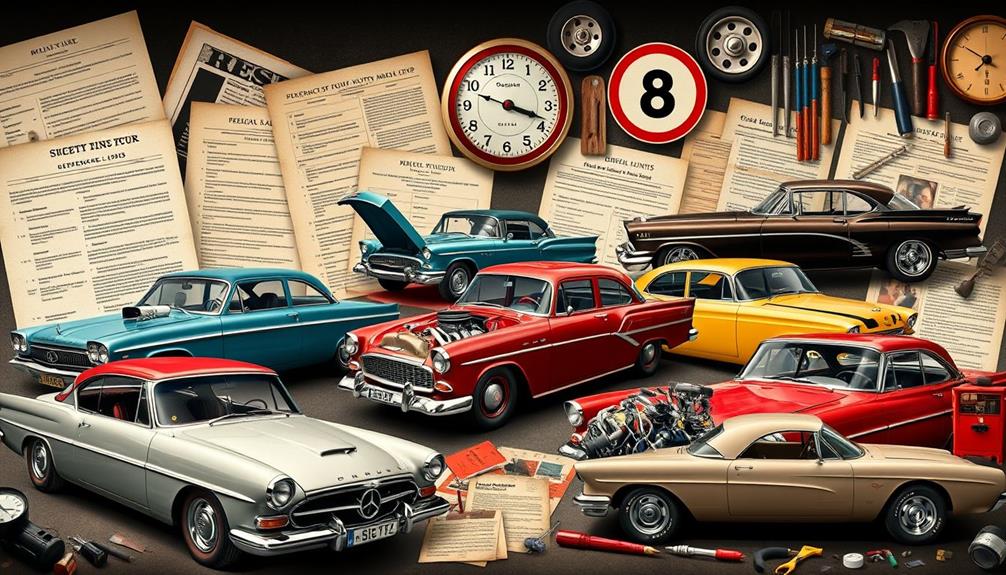
When you modify your vehicle, you need to keep legal compliance in mind, as regulations can vary by region.
If you're a young driver, there might be additional restrictions on the types of modifications you can make.
Plus, don't overlook environmental regulations, as they can impact your engine modifications and require certification to stay roadworthy.
Legal Compliance Requirements
Steering through the maze of legal compliance requirements is important for anyone considering car modifications. You need to make certain your modifications align with local and national regulations, which often include strict safety and emissions standards. These regulations are in place to confirm that your vehicle remains roadworthy.
Be aware that many regions enforce specific restrictions, particularly on modifications that affect engine performance. You may need certifications for aftermarket parts to legally operate your vehicle on public roads. If you're a young driver, additional legal requirements might limit the extent of the modifications you can undertake, so it's essential to check your local laws.
Documentation of all modifications is critical for legal compliance. Keep thorough records, as you may be required to present them during inspections or in the unfortunate event of an accident.
Additionally, if you plan to take your modified vehicle to competitive racing, you'll need to comply with regulations set forth by organizations like the FIA (Fédération Internationale de l'Automobile). Staying informed about these requirements will help you enjoy your modifications without legal hassles.
Environmental Regulations Impact
Steering through environmental regulations is vital for anyone looking to modify their vehicle. These regulations, especially smog laws, impose strict requirements on engine modifications, guaranteeing that modified vehicles meet specific emissions standards to remain street legal.
In regions like California, your modified vehicle must pass emissions testing, which can greatly limit the types of performance modifications you can implement. Additionally, many employers, similar to how background checks are conducted for safety and compliance, often require proof of adherence to local vehicle regulations before approving modifications.
Compliance with safety regulations is equally important. Authorities require inspections to confirm that any alterations don't compromise your vehicle's safety or structural integrity.
With the introduction of On-Board Diagnostics (OBD) systems, monitoring emissions and performance has become easier for authorities, leading to stricter controls over aftermarket modifications.
Ignoring local modification laws can lead to serious consequences, such as hefty fines, vehicle impoundment, and the inability to register your vehicle for road use.
As a result, before diving into any modifications, it's vital to fully understand the environmental regulations that apply to you. Staying informed not only protects your investment but also guarantees that your passion for car tuning doesn't run afoul of the law.
Young Driver Restrictions
Steering through the world of car modifications can be particularly tricky for young drivers. Many regions impose strict regulations on vehicle modifications to guarantee safety and compliance with legal standards.
As a young driver, you might find yourself facing age-related restrictions that prevent you from operating vehicles with significant performance modifications, such as engine swaps or excessive horsepower increases.
Insurance policies can also complicate things. If you own a modified vehicle, expect additional costs or restrictions since insurers view modifications as an increased risk.
Moreover, some areas require modified vehicles to pass stringent safety inspections, which can be especially challenging for young drivers who want to make certain their cars meet legal requirements.
To avoid fines, penalties, or even legal issues, it's wise to keep your vehicle modifications within legal limits. Familiarize yourself with local regulations and consult with experienced drivers or professionals.
Future Trends in Car Tuning
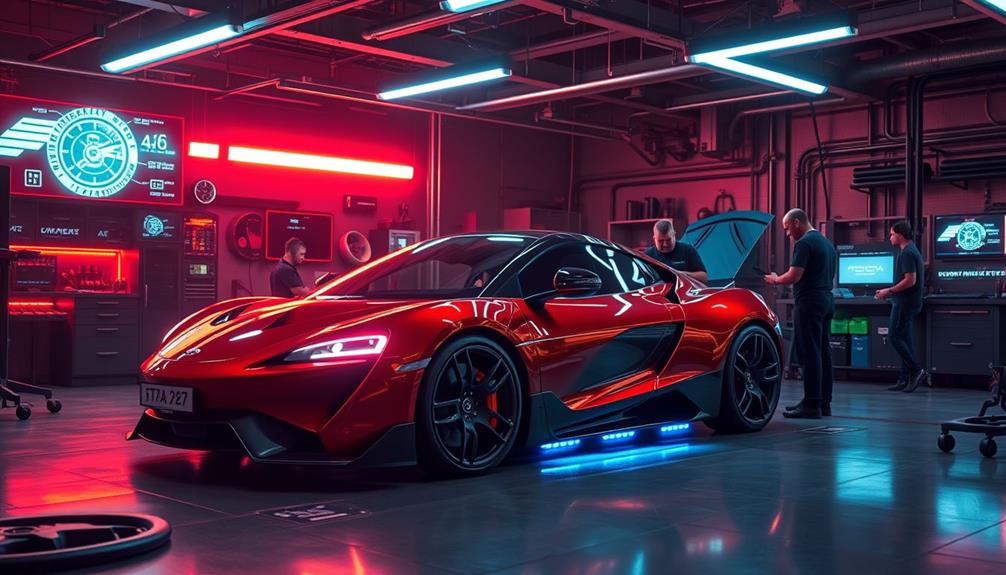
In the coming years, car tuning is set to evolve considerably, driven by the rise of electric and hybrid vehicles. As an enthusiast, you'll find that performance modifications will increasingly focus on enhancing efficiency without sacrificing power. This shift reflects a growing awareness of environmental impacts, pushing you to explore sustainable tuning practices and eco-friendly parts.
Furthermore, the integration of artificial intelligence in tuning and diagnostics is on the horizon. This technology promises to revolutionize how you customize your vehicle, allowing for precise adjustments and real-time monitoring, making your tuning experience more efficient than ever.
You can also expect the market for high-performance parts to expand, catering to a wider range of vehicle categories, including SUVs and crossovers.
Future trends will likely emphasize a balance between efficiency and performance, catering to your evolving preferences.
Frequently Asked Questions
When Did Car Modifications Start?
Car modifications started almost as soon as automobiles hit the streets. Early enthusiasts wanted more speed and unique styles, paving the way for a culture that continues to thrive today, blending performance and personal expression.
When Did Car Tuning Start?
Car tuning really began gaining traction post-World War II, as enthusiasts sought to enhance vehicle performance. You'll see it evolve considerably through the decades, with each era bringing new trends and customization opportunities for passionate drivers.
Where Did Tuner Culture Start?
Tuner culture started in the early 20th century, primarily in the United States. You'll find it blossomed post-World War II, fueled by veterans' passion for speed, eventually inspiring enthusiasts worldwide to modify their vehicles.
Is Tuning a Car a Modification?
You can't make an omelet without breaking a few eggs. Tuning a car is indeed a modification; it enhances performance and aesthetics by altering components like engines and suspensions to fit your driving style.
Conclusion
To sum up, car tuning has come a long way since its humble beginnings, evolving into a vibrant culture that fuels passion and creativity. Just as a musician fine-tunes their instrument for the perfect sound, you can personalize your vehicle to express your unique style and enhance performance. As technology advances and regulations change, the future of car tuning promises exciting possibilities. So, keep your eyes on the road and embrace the journey of performance modifications.
